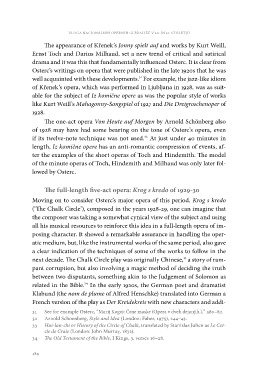Page 386 - Weiss, Jernej, ur. 2019. Vloga nacionalnih opernih gledališč v 20. in 21. stoletju - The Role of National Opera Houses in the 20th and 21st Centuries. Koper/Ljubljana: Založba Univerze na Primorskem in Festival Ljubljana. Studia musicologica Labacensia, 3
P. 386
vloga nacionalnih opernih gledališč v 20. in 21. stoletju
The appearance of Křenek’s Jonny spielt auf and works by Kurt Weill,
Ernst Toch and Darius Milhaud, set a new trend of critical and satirical
drama and it was this that fundamentally influenced Osterc. It is clear from
Osterc’s writings on opera that were published in the late 1920s that he was
well acquainted with these developments.31 For example, the jazz-like idiom
of Křenek’s opera, which was performed in Ljubljana in 1928, was as suit-
able for the subject of Iz komične opere as was the popular style of works
like Kurt Weill’s Mahagonny-Songspiel of 1927 and Die Dreigroschenoper of
1928.
The one-act opera Von Heute auf Morgen by Arnold Schönberg also
of 1928 may have had some bearing on the tone of Osterc’s opera, even
if its twelve-note technique was not used.32 At just under 40 minutes in
length, Iz komične opere has an anti-romantic compression of events, af-
ter the examples of the short operas of Toch and Hindemith. The model
of the minute operas of Toch, Hindemith and Milhaud was only later fol-
lowed by Osterc.
The full-length five-act opera: Krog s kredo of 1929-30
Moving on to consider Osterc’s major opera of this period, Krog s kredo
(‘The Chalk Circle’), composed in the years 1928-29, one can imagine that
the composer was taking a somewhat cynical view of the subject and using
all his musical resources to reinforce this idea in a full-length opera of im-
posing character. It showed a remarkable assurance in handling the oper-
atic medium, but, like the instrumental works of the same period, also gave
a clear indication of the techniques of some of the works to follow in the
next decade. The Chalk Circle play was originally Chinese,33 a story of ram-
pant corruption, but also involving a magic method of deciding the truth
between two disputants, something akin to the Judgement of Solomon as
related in the Bible.34 In the early 1920s, the German poet and dramatist
Klabund (the nom de plume of Alfred Henschke) translated into German a
French version of the play as Der Kreidekreis with new characters and addi-
31 See for example Osterc, “Marij Kogoj: Črne maske (Opera v dveh dejanjih.),” 380–82.
32 Arnold Schoenberg, Style and Idea (London: Faber, 1975), 244–45.
33 Hui-lan-chi or History of the Circle of Chalk, translated by Stanislas Julien as Le Cer-
cle de Craie (London: John Murray, 1832).
34 The Old Testament of the Bible, I Kings, 3, verses 16–28.
384
The appearance of Křenek’s Jonny spielt auf and works by Kurt Weill,
Ernst Toch and Darius Milhaud, set a new trend of critical and satirical
drama and it was this that fundamentally influenced Osterc. It is clear from
Osterc’s writings on opera that were published in the late 1920s that he was
well acquainted with these developments.31 For example, the jazz-like idiom
of Křenek’s opera, which was performed in Ljubljana in 1928, was as suit-
able for the subject of Iz komične opere as was the popular style of works
like Kurt Weill’s Mahagonny-Songspiel of 1927 and Die Dreigroschenoper of
1928.
The one-act opera Von Heute auf Morgen by Arnold Schönberg also
of 1928 may have had some bearing on the tone of Osterc’s opera, even
if its twelve-note technique was not used.32 At just under 40 minutes in
length, Iz komične opere has an anti-romantic compression of events, af-
ter the examples of the short operas of Toch and Hindemith. The model
of the minute operas of Toch, Hindemith and Milhaud was only later fol-
lowed by Osterc.
The full-length five-act opera: Krog s kredo of 1929-30
Moving on to consider Osterc’s major opera of this period, Krog s kredo
(‘The Chalk Circle’), composed in the years 1928-29, one can imagine that
the composer was taking a somewhat cynical view of the subject and using
all his musical resources to reinforce this idea in a full-length opera of im-
posing character. It showed a remarkable assurance in handling the oper-
atic medium, but, like the instrumental works of the same period, also gave
a clear indication of the techniques of some of the works to follow in the
next decade. The Chalk Circle play was originally Chinese,33 a story of ram-
pant corruption, but also involving a magic method of deciding the truth
between two disputants, something akin to the Judgement of Solomon as
related in the Bible.34 In the early 1920s, the German poet and dramatist
Klabund (the nom de plume of Alfred Henschke) translated into German a
French version of the play as Der Kreidekreis with new characters and addi-
31 See for example Osterc, “Marij Kogoj: Črne maske (Opera v dveh dejanjih.),” 380–82.
32 Arnold Schoenberg, Style and Idea (London: Faber, 1975), 244–45.
33 Hui-lan-chi or History of the Circle of Chalk, translated by Stanislas Julien as Le Cer-
cle de Craie (London: John Murray, 1832).
34 The Old Testament of the Bible, I Kings, 3, verses 16–28.
384


